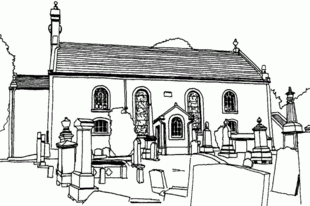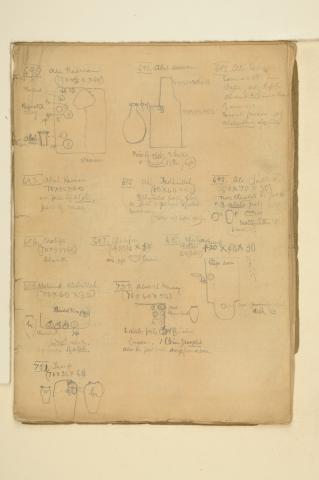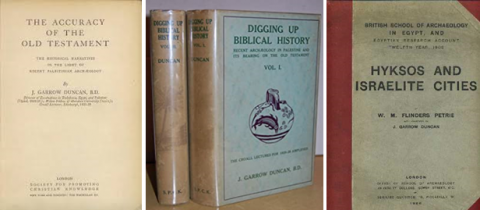Who was Reverend John Garrow Duncan?
By Nicky Doyle, MA Museum Studies student, UCL
Duncan, a Church of Scotland (CoS) ordained minister based in Kirkmichael, Scotland and a biblical history enthusiast, was born August 20th 1872 in Botriphny, Scotland to John Duncan (1847-1930) and Ann Annie Duncan (born Jessiman) (1842-1901) as one of three siblings. Duncan was married on February 27th 1901 to Katherine Sudding Duncan (born Reid) (1872-1933) and they had five children together. John Garrow Duncan (1872-1951), being the only son of John Duncan (1847-1930), would be expected to follow in his father’s footsteps and become a minister too. Duncan passed away on December 28th, 1951 at the age of seventy-nine in Scotland.
From the beginning, Duncan was shown to be a keen intellect. An 1899 report on Duncan’s school, Botriphnie School, conducted by an H.R.M. Inspector stated that
"The amount of higher work done in this school is one of its distinguishing features, showing thorough grounding and solid attainments. A pupil who received the bulk of his training in it stood 12th on the list of successful competitors at Aberdeen University bursary competition in October 1888."
This is in part in reference to Rev. John Garrow Duncan, showing he was indeed a bright student. Duncan went on to study theology at the University of Aberdeen and later went on to attend the British School at Athens. Few Scottish students were admitted directly from Scotland. During the session of 1894 to 1895, two theology students from Aberdeen went sent out, one of them being Duncan, who was sent by the Church of Scotland, and the other being an A.F. Findlay, who was sent by the United Presbyterian Church of Scotland.
In 1894, during Duncan’s time at the British School at Athens, he joined Flinders Petrie’s team at Naqada for six weeks. His motivation on this excavation appeared to be his interest in the link between Ancient Egypt and the Old Testament. According to Petrie he was an “active and precise observer, making excellent notes of the graves” (Petrie, W. M. F. and Quibell, J. 1896. Naqada and Ballas. London: Bernard Quaritch, p.12.). This is most likely where Duncan became more interested in Egyptology and his friendship with Petrie viewing him as a valuable colleague began, so much so that between 1905-06 Duncan conducted fieldwork with Petrie again.
It was during this year that Duncan and Petrie co-directed three sites: Shaghanbeh, located in the eastern Delta of the Nile; Saft el-Hinna, located in the Nile Delta, modern day Al Sharqia Governorate and Ghita, located near modern day Zagazig. The last two sites Hilda Petrie was a contributing Egyptologist on. Duncan also sponsored some of Petrie’s excavations. Some of the sites he has sponsored include: Piramesse (1885-86), Naqada (1894-95), Saft el-Hinna (1905-06) and el-Ballas (1894-95). From 1923-25 Duncan also became the Assistant Director of the Palestinian Exploration Fund (PEF). It appears that the way Duncan sponsored some of the site excavations mentioned could have been through his position in the PEF, such as with the excavations at the Ophel Hill, in modern day Israel, conducted by Duncan and Stewart Macalister in the 1920’s that PEF sponsored.
One of Duncan’s passions in life, apart from the church, was biblical history and looking for real life proof of events written about in the Bible, primarily the old testament. He wrote over forty books on the matter and was published in around one hundred and eighty-six publications. One could call him an expert on the matter. Four of his most well know pieces of work are: ‘The exploration of Egypt and the Old Testament; a summary of the results obtained by exploration in Egypt up to the present time, with a fuller account of those bearing on the Old Testament’, published between 1906-09, ‘Digging up biblical history; recent archaeology in Palestine and its bearing on the Old Testament’, published in 1931 and 1990, ‘New light on Hebrew origins’, published in 1936 and ‘Hyksos and Israelite cities’, co-written with W M. Flinders Petrie, published in 1
The collected artefacts of Rev John Garrow Duncan are spread across several collections in Scotland, with a sizable amount located at The Hunterian Museum. Several excavated objects were donated to the McManus Museum in Dundee by his son, John Gordon Duncan. There is no record of Duncan receiving objects from the excavations he was present on. However, in the Dundee’s McManus Art Gallery and Museum stores there are numerous Egyptian artefacts noted as being donated by him. It is not Duncan’s name that links this collection of objects together, but the labels written on the bases of the objects. A short sequence of letters and numbers that could be indicative of specific excavation seasons. In the Special Collections of the University of Glasgow, there are several papers which document cases of Egyptian pottery being sent to Professor Stevenson by Garrow. Many of the objects acquired by him from Duncan’s participation in excavations such as Naqada and Ballas, are now accessioned into the collection of the Dundee McManus Museum.
Without a doubt, Duncan in his time rose to prominence in the world of Egyptology. Now, it was not unusual for a church reverend to take an interest in the world of archaeology in this time period. What is special about this case is the level that Duncan rose to. As the assistant director of Palestine Exploration Fund, Duncan would have had a say in what sites the fund would sponsor. Not only would he be able to investigate sites he might have had a personal interest in, but also receive first hand information of how the field of Egyptology and archaeology were progressing in the exciting era of new discoveries that were the 1920’s. Without a doubt, it can be agreed upon that Duncan left an impact on the world of Egyptology, from working and befriending leading figures, like Flinders and Hilda Petrie and Stewart Macalister, to publishing works that are still being referenced to this day in the world of biblical archaeology. He was a very accomplished person and should be remembered so.

An illustration of Kirkmichael Parish Church where Duncan was the reverend in the early 20th Century. Image from Scotland’s Churches Trust.

Page 14 from Petrie’s notebook. This page details the site features 690-99 and 750-51. Duncan most likely worked on these features; it is highly possible that Duncan drew some of these figures (Available from the Petrie Museum, 991-147_004).

A selection of books written (and co-written) by Duncan. Left to right: ‘The Accuracy of the Old Testament’ (1930), ‘Digging Up Biblical History’ (1931-90), ‘Hyksos and Israelite Cities’ co-written with F. Petrie (1906, 2010).
